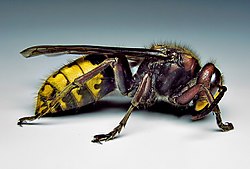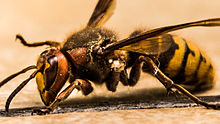| Revision as of 05:08, 25 May 2014 edit108.252.86.36 (talk)No edit summary← Previous edit | Revision as of 05:18, 25 May 2014 edit undoMaterialscientist (talk | contribs)Edit filter managers, Autopatrolled, Checkusers, Administrators1,994,296 editsm Reverted edits by 108.252.86.36 (talk) to last version by YyyikesNext edit → | ||
| Line 3: | Line 3: | ||
| | image = Hornet-vespa.jpg | | image = Hornet-vespa.jpg | ||
| | image_width = 250px | | image_width = 250px | ||
| | status = |
| status = LC | ||
| | status_system = iucn3.1 | | status_system = iucn3.1 | ||
| | image_caption = A female European hornet | | image_caption = A female European hornet | ||
Revision as of 05:18, 25 May 2014
| European Hornet | |
|---|---|

| |
| A female European hornet | |
| Conservation status | |
 Least Concern (IUCN 3.1) | |
| Scientific classification | |
| Kingdom: | Animalia |
| Phylum: | Arthropoda |
| Class: | Insecta |
| Order: | Hymenoptera |
| Family: | Vespidae |
| Genus: | Vespa |
| Species: | V. crabro |
| Binomial name | |
| Vespa crabro Linnaeus, 1758 | |
The European hornet (Vespa crabro), commonly known simply as the "hornet," or "bell hornet" in the mid-Atlantic region of the United States, is the largest European eusocial wasp, and the largest hornet in North America. The queen measures 25 to 35 mm (1–1.4 in) long; workers are 18–24 mm. In males, as in most members of the Aculeata, the antennae have 13 segments, while in females there are only 12; also as in other aculeates, the male abdomen has seven visible segments, while the female has six; females possess an ovipositor modified into a sting which is not barbed. See wasp and bee characteristics to help identify similar insects.
This species will sting in response to being stepped on or grabbed but generally avoid conflict. They are also defensive of their hive and can be aggressive around food sources. They are carnivorous and eat large insects: primarily wasps, large moths, and other large bees. Care should be taken when encountered in these circumstances as they may sting without warning. The pain from the sting may persist for several days with attendant swelling. If you are stung you may wish to seek medical attention.
Description


The eyes are deeply indented, shaped like a C. The wings are reddish-orange, while the petiolate abdomen is brown striped with yellow. The European hornet is larger than the common wasp, but smaller than some Asian hornet species. It has hair on the thorax and abdomen, although the European hornet is not as hairy as most bees.
European hornets do not have the rove beetle Velleius dilatatus living in their colonies.
Life cycle
The nest is founded in spring by a fertilized female known as the "queen". She generally selects sheltered places like dark hollow tree trunks. She first builds a series of cells (up to 50) out of chewed tree bark. The cells are arranged in horizontal layers named combs, each cell being vertical and closed at the top. An egg is then laid in each cell. After five to eight days, the egg hatches, and over the next two weeks, the larva undergoes five moults. During this time, the queen feeds it a protein-rich diet of insects. Then, the larva spins a silk cap over the cell's opening and, during the next two weeks, transforms into an adult, a process called metamorphosis. The adult then eats its way through the silk cap. This first generation of workers, invariably females, will now gradually undertake all the tasks formerly carried out by the queen (foraging, nest building, taking care of the brood, etc.) with one exception: egg-laying, which remains exclusive to the queen.

As the colony size grows, new combs are added, and an envelope is built around the cell layers until the nest is entirely covered with the exception of an entry hole. At the peak of its population, the colony can reach a size of 700 workers, which occurs in late summer.
At this time, the queen starts producing the first reproductive individuals. Fertilized eggs develop into females (called "gynes" by entomologists), and unfertilized ones develop into males (sometimes called "drones"). Adult males do not participate in nest maintenance, foraging, or caretaking of the larvae. In early to mid autumn, they leave the nest and mate during "nuptial flights". Males die shortly after mating. The workers and queens survive at most until mid to late autumn; only the fertilized queens survive over winter.
Relationship with humans
Urban legends
This section has multiple issues. Please help improve it or discuss these issues on the talk page. (Learn how and when to remove these messages)
|


European hornets are often mischaracterised as very aggressive and dangerous, and are greatly feared by some people. Some people believe that "three stings from the European hornet can kill an adult human, and seven can kill a horse". These are common myths – a sting from a European hornet is no more dangerous than any other wasp sting, and European hornets are usually less aggressive than other wasps. In contrast, multiple Asian giant hornets stings are, in fact, more dangerous. While impressive due to their size and loud sound, European hornets are in fact much less aggressive than some of their smaller relatives, such as the German Wasp and the common wasp. When approached, European hornets can actually be seen to slowly crawl backwards and eventually flee, rather than attack. This can make it hard to remove hornets from indoors, if they happen to come in through an open window or door. Although not aggressive when encountered far from the nest, multiple workers will vigorously defend the nest if provoked. Nests can be approached without provocation (by moving slowly and not breathing towards the nest) to about 50 cm (20 in). Nests are usually not a problem outside buildings, but because they drip feces, a bad-smelling black liquid, nests inside sheds or walls can be a problem.
Endangered species and legal protection
Unwarranted fear has often led to the destruction of nests, leading to the decline of the species, which is often locally threatened or even endangered. European hornets benefit from legal protection in some countries, notably Germany, where it has been illegal to kill a European hornet or nest since 1 January 1987, with a fine of up to 50,000 Euros.
Attraction to lights and food
European hornets are attracted to lights at night, but are not attracted to human foods and food wastes. However, they can totally destroy fruits, such as apples, while the fruit is still on the tree. This is quite unlike the bald-faced hornet or other social wasps.
Problems associated
European hornets are carnivores and eat many species of insects. Many of these insects are considered pests in the garden, which indicates that the hornet provides a benefit to the average garden/farm. However, they are known to eradicate domestic honeybee hives, resulting in fewer honeybees for open pollination. They also tend to girdle branches, which results in dead branches.
Geographic colour forms


European hornets worldwide are found with geographic colour forms:
- Vespa crabro crabro Linnaeus, 1758
- Vespa crabro vexator Harris, 1776. A European hornet found in southern counties of England, and continental Europe. This subspecies can be distinguished from the Common European hornet as V. crabro vexator has a yellow head.
- Vespa crabro germana Christ, 1791
- Vespa crabro crabroniformis Smith, 1852
- Vespa crabro borealis Radoszkowski, 1863
- Vespa crabro oberthuri du Buysson, 1902
- Vespa crabro flavofasciata Cameron, 1903
- Vespa crabro altaica Pérez, 1910
- Vespa crabro caspica Pérez, 1910
- Vespa crabro chinensis Birula, 1925
See also
Notes
- "European Hornet".
- "Hornets are worthy of protection!".
- http://www.ca.uky.edu/entomology/dept/entfacts.asp
- V. Dubatolov, J. Kojima, J. M. Carpenter, A. Lvovsky (2003). "Subspecies of Vespa crabro in two different papers by Birula in 1925". Entomological Science. 6 (2003): 215–216. doi:10.1046/j.1343-8786.2003.00037.x.
{{cite journal}}: CS1 maint: multiple names: authors list (link) - J.M. Carpenter, J. Kojima (1997). "Checklist of the species in the subfamily Vespinae (Insecta: Hymenoptera: Vespidae)". Natural History Bulletin of Ibaraki University. 1 (1997): 51–92.
- "Hornets in Great Britain". hornissenschutz.de. Dieter Kosmeier. Retrieved 25 November 2011.